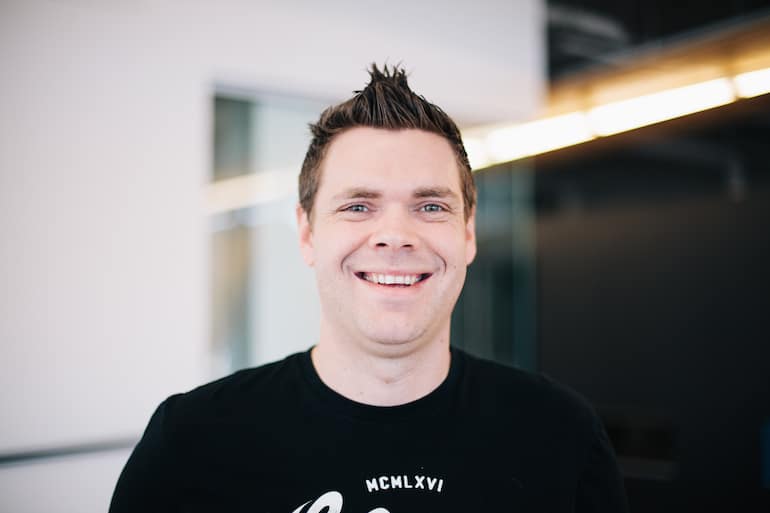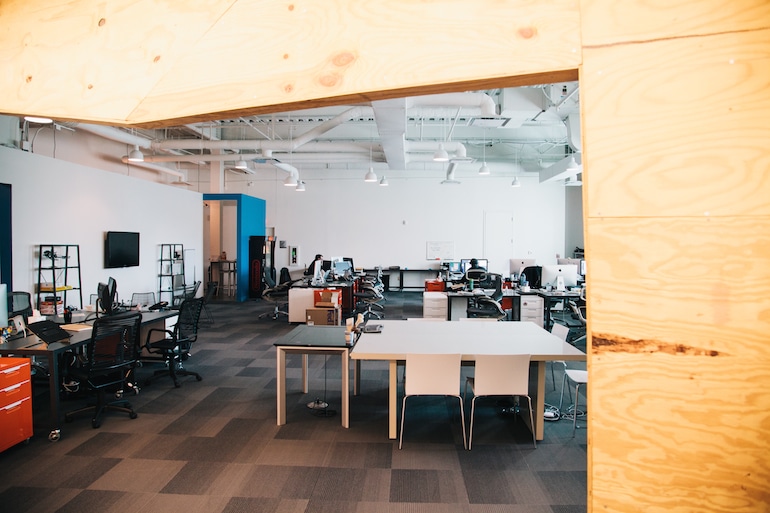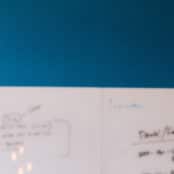
Phenomblue styles itself today as a brand experience agency. It looks like they do it all: create strategy, design, build sites, and basically conceptualize and produce the whole package of a company’s voice. But step back, if you will, 10 years to see a rather different picture.
“We started out in 2004 as an animation studio actually,” says Joe Olsen, founder and CEO at Phenomblue. A team of about a dozen developers took on projects from movie studios like Universal, big effects companies like Rhythm & Hues, and production studios working on commercials for ad agencies. But around 2006, the Omaha-based studio made its first move toward scaling up.
Are you ready to cut out the middleman?
“We decided to just skip the production companies and go straight to the agencies,” Olsen says. From there, the ad agencies started asking for tech help—could Phenomblue take its animation and put it on a website, for example?
“There were only a handful of places around the country that could actually do really high-end animation and the software development in the same place,” Olsen says. “For an agency, it was a good deal for them because they’d only have to go to one spot instead of trying to get two companies to work together.” For the next five or six years, Phenomblue took off with the big agencies in Chicago and the east coast, serving as a third-party digital partner and working on projects for brands like Nike, McDonalds, and Gatorade.
Is your service becoming a commodity?
It was around 2010 when Olsen noticed a disturbance in the market place force. Clients were firing ad agencies and simply hiring the third-party companies producing the work. “Imagine Pepsi going around Saatchi and saying, ‘We’re just going to hire Phenom,’” Olsen explains. “So that happened a couple times in the market and that kind of rifted through on the agency side and everyone got kind of scared. ‘Are we letting these guys get too close the client?’ Because that’s really what agencies own is the relationship with the client.”
Suddenly Phenomblue was no longer permitted at the meeting table with Pepsi. “We got moved all the way back behind the curtain again,” Olsen says. “So we could see the writing on the wall—we could try to work our way back up there again, but it’s a long road, and at any point in time we could get knocked all the way back again.”
He describes the situation as being commoditized. “It was starting to get about how fast can you do it, how cheap can you do it.” Not that that’s a bad thing for every digital agency. Olsen points out that the big advertising agencies have so much money, a five-to-10-person dev shop could run a really nice lifestyle business picking off small projects for them.
Is payroll an issue?
Unfortunately, as of 2011, Phenomblue had already grown to 40 employees and was still bidding against those smaller shops. “You’re never going to win that game, because they can do it cheaper,” he says. “When you have a $250,000/month payroll, that’s a lot of $30,000-websites to turn around in 30 days. So you can’t do $30s anymore, you’ve got to do $100s or $300s. Well, when you get into that game, there’s always a bigger firm.”
Phenomblue’s choice was either to get bigger or get smarter: grow to 200 people to get some scale or do things that are worth more money to the client, rather than focus on being the cheapest.
Do your clients need more than they’re asking for?
Yes, a client may need a website, but do they know why they need it? Answering that question and others like it is how Phenomblue stopped turning clients away and instead turned them into long-term accounts.
Think this sounds like business consulting?
“Yeah, it’s really strange, we are sort of,” Olsen agrees. “The work we’re doing with one of our bigger clients right now—we’re spending most of our time planning what a future picture of that organization looks like. What does financial success mean, what does outside and inside perception look like, what does your market position look like. What kind of measurements do we put in place to make sure we’re achieving those goals? And out of that what can we do to make those measurements move? And then you can get into doing things.”
There’s a hole in the industry for strategy, he says. Companies generate lots of activity without pausing for breath to solidify a goal. “We need Facebook, we need this, we need that, we need a new brand, we need to run some TV commercials—but push all that to the side and ask ‘Why do you need this?’”
For the last 10 years, Olsen says, marketers have been trying to understand how consumers use technology to connect to brands. “Whether that’s devices or media like the internet or behaviors like social, you’re just constantly trying to figure out how people like us who have these things on us all the time—” he picks up his phone resting on the table “—how do we work?”
Do you have the guts to change your business model?
But helping clients figure out how digital consumers tick meant that Phenomblue had to change up its own business model. For the past three years, it’s been a long, slow haul. “We went from 40 [full-time employees] to 17, and I think we’re at 15 today,” Olsen estimates. Shifting from a completely full-time staff to a hybrid model enabled Phenomblue to keep its permanent staff strategic while contracting more commoditized skills. “We’ll probably be at 20-25 by the end of the year.”
Today, its office in Midtown Omaha houses a staff that’s half creative and strategy and half project management and account administration. The work done inhouse is about 90 percent strategy and creative and 10 percent development. “Whereas two to three years ago, it was completely flip-flopped,” Olsen recalls.
Staffing changes are a necessary evil of business, but he’ll admit that it still kind of sucks. “You have all these people who started out with you when your business was one way, and then when you change the business, you sort of have to move people around. It was all premeditated, but it’s always hard to do that.” Olsen adds that a lot of the people he had to let go weren’t not good at their jobs but were being utilized maybe only 10 percent of the time.
It wasn’t just the faces that changed at Phenomblue. “We had to change everything,” Olsen says. “The way we sold projects, the way we build, the way we staff, we had to change all that stuff. We had to figure out how to run accounts, which is totally different than running a big project. We spent a lot of time running into the wall before we did.”
One such wall included what type of person to bring on board. Since no one at Phenomblue had worked in an ad agency before, the team figured they should bring on someone who could show them the ropes.
“What happened was they brought in these sort of legacy ways,” Olsen says. “The agency world is very hierarchical—people have bosses and bosses and bosses, and our place is really flat.” So when a previous bigshot from a large ad agency got a question from a junior project manager, the legacy response tended to be something like, ‘Why do I have to tell you anything?’
Along with rejecting the hierarchy model of ad agencies, Phenomblue chose to follow a more metric-based method for adding clients. “We have a PMO group now,” Olsen says. “We have somebody saying we’re not doing work unless we make this much on it—that person’s responsible for deciding whether we outsource or work internally. In the agency world, you don’t see that very much. You win the biggest projects you can, you look for big names. It’s more about big swells than it is a natural sort of progression.”
Are you dreaming big?
Stepping away from digital partnership with big agencies like Saatchi meant that Phenomblue also had to step away from working with huge brands like McDonalds and Gatorade–for a while. “When we went direct, you’re not going to go work for those kind of clients because they’re just too big,” Olsen explains. Phenomblue went instead for small business and startup clients, working their way back up the marketing ladder. “We only came out of that dip about six or seven months ago,” he says, adding that now they’re working with some bigger clients again like GuitarCenter, eBay, and Newegg.
But laurels will not be rested on. “Mergers and acquisitions will be a part of our growth pattern—for sure,” Olsen says with emphasis. “So that brings on other challenges. When you want to grow big, you can’t do it just by adding people organically, especially in our space. These channels open up where people need help, and someone will fill it if you don’t.”












Comments ( 2 )
Jonathan Sharp
May 15, 2014
Great article and associated imagery. Was great to better understand the challenges and pivots to address them.
Joseph Graves
April 29, 2014
Great article Chris, we all need to do a better job of thinking about our value proposition.
However, I wouldn't correlate thinking strategically with thinking bigger. We are a team of 4 and yet we start every client engagement as "consultants." Before we can create, we need to understand our their business in order to provide great solutions. Being creative order takers diminishes the value of the experience we bring to the table and does a disservice to our clients.
Part of the benefit of clients working with creative companies is the diversity of our experience, we all need to do more to communicate the value of that brings.My hope is that all website/ marketing/ tech companies would start thinking strategically about the outcomes our work is intended to achieve.
Businesses need us, let's deliver on the value creation side...we want clients writing huge checks - and being happy to do so.
What do you think?